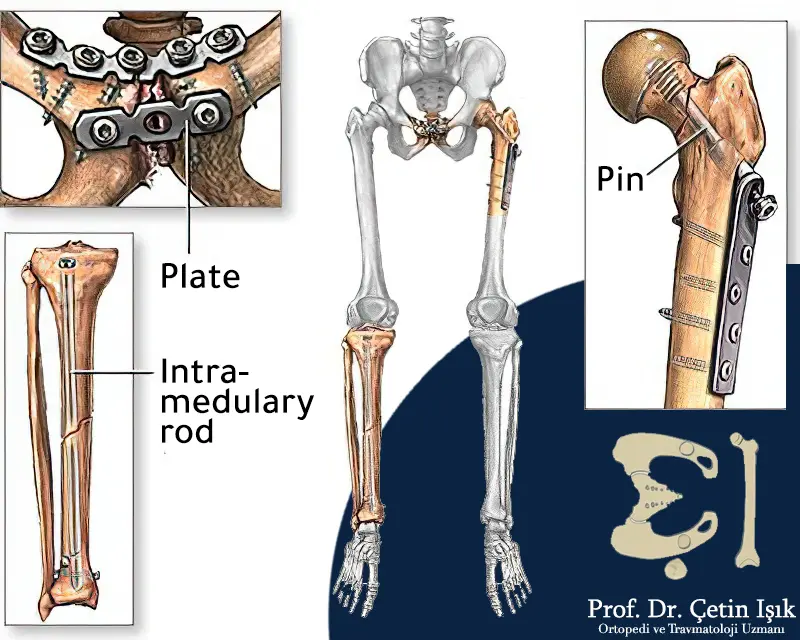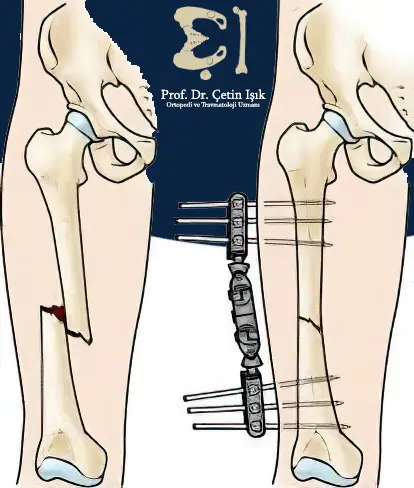Internal fixation of long bones is a surgical procedure to repair bone fractures by holding the broken ends together using implants such as plates, screws, and rods.
The newly broken bone needs to be kept in a stable position in its correct place until healing is achieved. In cases of simple fractures, the splint ensures that, but for complex fractures, we need to implant a metal plate and fix it with screws with the bone fragments, which is what is called internal fixation of the bones.
Internal bone fixation for fracture treatment allows for less hospital stays, enables patients to return to normal activities earlier and reduces the chances of bone fractures failing to heal.
Continue with us in this article to learn about the internal fixation of broken bones, the types of implants used, and the most important advantages and disadvantages associated with this procedure.
What is internal fixation of bones?
Internal fixation of bones is defined as a surgical procedure that involves implanting metal fixators to fix broken bones. Implants can be in the form of plates or screws that hold bone fragments in place. Usually, fixators are not removed from the patient's body even after bone healing, except in specific cases.
The internal fixation of bones has several advantages, as it works on:
- Reducing or eliminating the pain of a bone fracture
- Allowing early movement of joints and extremities
- Reducing the rehabilitation period after the surgical procedure
- Bone fragments healed with proper alignment
- Maintaining blood perfusion of subcutaneous tissue
Uses of internal fixation of bones
The doctor resorts to the internal fixation of the bone and is the best option in the treatment of fractures in the following cases:
- Fractures extending to the joint cartilage
- Fractures that have caused other injuries that require surgery, such as nerve or arterial damage
- An open fracture that exposes the skin and has an increased risk of infection
- Fractures that require a long time to heal, such as fractures of the head of the femur
Types of internal orthopedic fixations
Orthopedic devices consist of internal implants made of durable and strong materials such as stainless steel or titanium alloys.

Depending on the severity and type of damage to the broken bone, the doctor chooses the type of fixator from several options, including the following:
Plates
Plates are like internal splints that hold the broken pieces together and are secured to the bone with screws.

Screws
Although the screw is a simple device, it is the most widely used type of internal fixation. They are available in various bone designs and sizes and can be used alone or in combination with plates and wires.
Bars or nails
It is one of the best ways to hold pieces of bone together in some long bone fractures such as: leg fractures or femur fracturesIn which a rod or nail is inserted into the bone cavity, the doctor uses the rods in conjunction with the screws to prevent the fractures from rotating and hold them in place.

Wires
Wire is usually used in very small fractions such as Hand fractures or foot and can be used in conjunction with other implants
The difference between internal and external fixation for the treatment of bone fractures
External fixation is one of the methods of repairing fractures through a device placed outside the skin that fixes bone fragments temporarily with pins or wires attached to the rods and is removed after healing, and it has the ability to modify the externally installed device.

The difference between internal and external fixation is the mechanism of surgery and the location of the orthopedic devices, and the common goal between them is to correct the alignment and heal the bones properly.
Open Reduction and Internal Fixation of bones ORIF
It is a two-stage surgical procedure; It begins with an open reduction, as the doctor makes an incision in the skin and restores the bone to its correct position, then proceeds to fixation by inserting a metal plate with wires or screws to connect the bones.
X-rays are often used during fixation surgery to check that the bones are orthotics and are aligned properly. The incisions are then closed with sutures and covered with a bandage.
Complications of internal fixation for orthopedic treatment
The internal fixation of bones for the treatment of fractures comes with certain risks, such as:
- Damage to nerves or other bone and blood vessel tissues
- Stiffness, numbness, or weakness in the affected area
- Bacterial infection of either the device or the incision
- Decreased or lost the motor ability
- Compartment syndrome, which occurs when there is increased pressure in an arm or leg
- Allergic reaction to hardware or irritation of skin and soft tissues
- Bone misalignment or improper healing
- The need for additional surgeries due to hardware issues such as looseness
Cases of implant removal after internal fixation of fractures
To date, there is no controlled study that would differentiate between the benefits and harms of removing the fixation implant for patients, and the indications for removing the retainer vary depending on several factors that need to be taken into account, including:
- The age of the injured
- The degree of fracture and the size of the bone gap
- The degree of injury to the tissues in the vicinity of the fracture
- stability of the stabilizer and the accuracy of the response
- The presence of a graft for the fractured bone
The following set of conditions include important indications for the removal of the implant used in internal fixation:
- Infection at the implantation site
- Implant protrusion
- Broken or unstable implants
- Bone healing failure
- Skin and tissue irritation as a result of a protruding implant
Finally, internal fixation of bones is an important technique in the surgical management of bone fractures of the body as it has helped speed up the healing of a severe bone fracture while providing aseptic conditions that significantly reduce the risk of infection.
Sources:
Common questions
Internal fixation is done to treat a broken bone by making a surgical incision, then placing the bones in the correct place, with proper alignment, and fixing the ends. For this, we use fixtures such as a metal plate or screws and nails. These devices remain attached to the bone under the skin. Finally, the incision is closed with stitches and covered with a bandage.
In most cases, bone fixation surgery takes one to two hours or more, depending on the degree of bone fracture and tissue damage.
In many cases, the external fixators remain from several weeks to months, as most fractures heal within 6 to 12 weeks, and it may take longer to fix the injury if there are accompanying health problems.
It is not allowed to walk after internal fixation surgery until after six weeks, and you must follow up with a physiotherapist and adhere to the required care instructions
Serious and severe fractures need to be treated by internal fixation surgery, especially displaced or unstable fractures, or those that extend to the joints.




